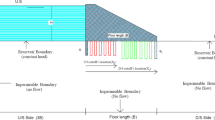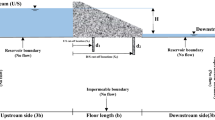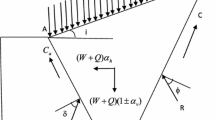Abstract
A Genetic Algorithm model, coupled with Finite Element Programming (GA-FEP), has been developed to create an optimal design for hydraulic structures to address seepage problems. While the objective function of the optimization model was to minimize the construction costs of the hydraulic structure, the main constraints were to satisfy safety factors concerning uplift pressure and exit gradient. The GA-FEP model proposed here meets the requirements of an optimal hydraulic design in two stages. Firstly, a validated numerical model coded using Finite-element Programming (FEP), was used to analyze seepage problems. This was followed by application of Genetic Algorithm (GA) and finite-element programming (FEP) to establish the optimum depth and location for cut-offs. A MATLAB programming code was used to create the link between the numerical and optimization model, creating a simulation–optimization (S–O) model. The effects of hydraulic conductivity and anisotropic ratios on the hydraulic structure design, were also investigated. The results indicate that the proposed GA-FEP model will provide a safe, efficient and economical hydraulic cut-off design. Evaluation of the model revealed acceptable agreement between expected and simulated seepage parameters pertinent to the hydraulic structure design.








Similar content being viewed by others
Availability of Data and Material
All data used in this work are available from the corresponding author by request.
Code Availability
The codes used in this work are available from the corresponding author by request.
References
Al-Delewy AA, Shukur A-HK, AL-Musawi WH (2006) Optimum design of control devices for safe seepage under hydraulic structures. J Eng Dev 10:66–87
Al-Juboori M, Datta B (2019) Performance evaluation of a genetic algorithm-based linked simulation-optimization model for optimal hydraulic seepage-related design of concrete gravity dams. J Appl Water Eng Res 7:173–197
Al- Saadi SI, Al-fatlawy RA (2007) Effect of degree of anisotropy on exit gradient under dams using the finite element method. M.Sc. Thesis, Department of Civil Engineering, University of Kufa, Iraq
Al-Suhaili RH, Karim RA (2014) Optimal dimensions of small hydraulic structure cutoffs using coupled genetic algorithm and ANN model. J Eng 20:1–19
Alsenousi KF, Mohamed HG (2008) Effects of inclined cutoffs and soil foundation characteristics on seepage beneath hydraulic structures. In 12th International Water Technology Conference. pp 1597–1617
Azizi S, Salmasi F, Abbaspour A, Arvanaghi H (2012) Weep hole and cut-off effect in decreasing of uplift pressure, case study: Yusefkand Mahabad Diversion Dam. J Civ Eng Urban 2:97–101
Das BM, Das BM (2008) Advanced soil mechanics. Taylor & Francis New York
El-Jumaily KK, AL-Bakry HMJ (2013) Seepage analysis through and under hydraulic structures applying finite volume method. Eng Technol J 31:1719–1729
Garg NK, Bhagat SK, Asthana BN (2002) Optimal barrage design based on subsurface flow considerations. J Irrig Drain Eng 128:253–263
Harr ME (1991) Groundwater and seepage. Courier Corporation
Hassan WH (2017) Application of a genetic algorithm for the optimization of a cutoff wall under hydraulic structures. J Appl Water Eng Res 5:22–30. https://doi.org/10.1080/23249676.2015.1105161
Hassan WH (2019) Application of a genetic algorithm for the optimization of a location and inclination angle of a cut-off wall for anisotropic foundations under hydraulic structures. Geotech Geol Eng 37:883–895. https://doi.org/10.1007/s10706-018-0658-9
Hassan WH, Jassem MH, Mohammed SS (2018) A GA-HP model for the optimal design of sewer networks. Water Resour Manag 32:865–879. https://doi.org/10.1007/s11269-017-1843-y
Jalal HK, Hassan WH (2020) Effect of bridge pier shape on depth of scour. In IOP Conference Series: Mat Sci Eng (Vol. 671, No. 1, p. 012001). IOP Publishing.
Khoramshokooh N, Veiskarami M, Nikoo MR, Pourvahedi Roshandeh S (2018) Multi-objective hydraulic optimization of diversion dam’s cut-off. Water Resour Manag 32:3723–3736. https://doi.org/10.1007/s11269-018-2015-4
Lambe TW, Whitman RV (1991) Soil mechanics. John Wiley & Sons
Mansuri B, Salmasi F, Oghati B (2014) Effect of location and angle of cutoff wall on uplift pressure in diversion dam. Geotech Geol Eng 32:1165–1173. https://doi.org/10.1007/s10706-014-9774-3
Moharrami A, Moradi G, Bonab MH et al (2015) Performance of cutoff walls under hydraulic structures against uplift pressure and piping phenomenon. Geotech Geol Eng 33:95–103. https://doi.org/10.1007/s10706-014-9827-7
Nikoo MR, Gavahi K, Khoramshokooh N (2019) A multi-objective simulation-optimization approach for design of cutoff walls and apron of diversion dams. Iran J Sci Technol Trans Civ Eng 43:241–252. https://doi.org/10.1007/s40996-018-0134-z
Rani D, Moreira MM (2010) Simulation-optimization modeling: A survey and potential application in reservoir systems operation. Water Resour Manag 24:1107–1138. https://doi.org/10.1007/s11269-009-9488-0
Rehamnia I, Benlaoukli B, Heddam S (2020) Modeling of seepage flow through concrete face rockfill and embankment dams using three heuristic artificial intelligence approaches: a comparative study. Environ Process 7:367–381. https://doi.org/10.1007/s40710-019-00414-6
Salmasi F, Nouri M, Abraham J (2020) Upstream cutoff and downstream filters to control of seepage in dams. Water Resour Manag 34:4271–4288. https://doi.org/10.1007/s11269-020-02674-6
Shahrbanozadeh M, Barani G-A, Shojaee S (2015) Simulation of flow through dam foundation by isogeometric method. Eng Sci Technol Int J 18:185–193. https://doi.org/10.1016/j.jestch.2014.11.001
Shourian M, Mousavi SJ, Menhaj MB, Jabbari E (2008) Neural-network-based simulation-optimization model for water allocation planning at basin scale. J Hydroinformatics 10:331–343
Sreekanth J, Datta B (2011) Coupled simulation‐optimization model for coastal aquifer management using genetic programming‐based ensemble surrogate models and multiple‐realization optimization. Water Resour Res 47
Author information
Authors and Affiliations
Contributions
W.H.H and D.H.K.; Methodology; Formal analysis and investigation; Writing—original draft preparation: D.H.K; Writing—original draft preparation: W.H.H, H.H.H, M.H.A and B.K.N; Writing—review and editing: W.H.H and B.K.N; Supervision.
Corresponding author
Ethics declarations
Ethical Approval
Not applicable.
Consent to Participate
Not applicable.
Consent for Publication
Not applicable.
Conflicts of Interest/Competing Interests
The authors declare no conflicts of interest.
Additional information
Publisher's Note
Springer Nature remains neutral with regard to jurisdictional claims in published maps and institutional affiliations.
Appendix A
Appendix A
1.1 Steps of the Proposed Model (GA-FEP Model)
Design Variables Encoding
The GA necessitates that any trial solution of the design problem be represented by a coded string of finite length, similar to the structure of the chromosomes in a genetic code. Each chromosome from a population signifies one design, the depth and location of two cut-offs coded as genes. The length of a chromosome is equal to four genes, the depth (d1) and location (x1) for the first cutoff and the depth (d2) and location for the second cutoff (x2); any gene in a chromosome represents the depth and location for a cutoff coded by integer coding. As shown in Table 1, a selection of cutoff depths was considered and represented as integer coding.
-
1.
Initial population generation: At this stage, the algorithm generates a random population of chromosomes that represent trial solutions to the hydraulic structure design problems. The GA-FEP model was used on a population of 50 in this study.
-
2.
Population decoding: the strings in the population are decoded to produce a set of possible solutions to seepage flow issues.
-
3.
Invoking the FEP subroutine: for each chromosome situated inside the parent pool, the FEP is utilized to compute the total water head at any node within the domain, including the quantity of seepage, exit gradient, uplift pressure and cost of construction for every chromosome generated as per the following:
-
(a)
Determination of hydraulic properties for the hydraulic structure: at this stage, all hydraulic properties are obtained. All these properties are computed by applying the steady-state seepage analysis.
-
(b)
The penalty cost: a penalty cost is assigned to each chromosome if a proposed solution does not fulfill one or more constraints.
-
(c)
Total cost computation: total construction costs are determined by the summation of the superstructure and cut-off wall costs, which are displayed in the objective function equation.
-
(a)
-
4.
Fitness computation: Each chromosome's fitness in the population is represented here. In this step, fitness function is calculated. This can be thought of as the total cost inverse.
-
5.
New generation (population creation): The following stages must be repeated until the new generation (population) is complete in order to generate a new one:
-
5.1
Selection: the selection of the best two parent chromosomes from a population is based on their fitness: the better their fitness, the more likely they are to be chosen. In this study, the Roulette Wheel Selection (RWS) method was used.
-
5.2
Crossover: parent’s crossover to create new children (offspring). If there is no crossover procedure performed, the children are an exact replica of their parents. In the current study, a crossover approach was taken into consideration where Pc = 0.95.
-
5.3
Random Mutation: for each string that has experienced crossover, a random mutation is performed with a probability of mutation (Pm). A random mutation factor with Pm = 0.05 is utilized by replacing the length of the upstream cut-off by the depth of the downstream cut-off in a chromosome.
-
5.1
-
6.
The production of subsequent generations: generation a new trial design of the hydraulic structure is produced by the three operators outlined above.
-
7.
Convergence of the model: the procedure described in steps 3 to 7 is repeated until the convergence conditions for the basic genetic algorithm search, as defined by the designer, are met. To be classified as "converged", the basic GA search must have reached its optimal answer after a certain number of generations without any further improvement.
Rights and permissions
Springer Nature or its licensor holds exclusive rights to this article under a publishing agreement with the author(s) or other rightsholder(s); author self-archiving of the accepted manuscript version of this article is solely governed by the terms of such publishing agreement and applicable law.
About this article
Cite this article
Hassan, W.H., Hussein, H.H., Khashan, D.H. et al. Application of the Coupled Simulation–optimization Method for the Optimum Cut-off Design Under a Hydraulic Structure. Water Resour Manage 36, 4619–4636 (2022). https://doi.org/10.1007/s11269-022-03269-z
Received:
Accepted:
Published:
Issue Date:
DOI: https://doi.org/10.1007/s11269-022-03269-z




